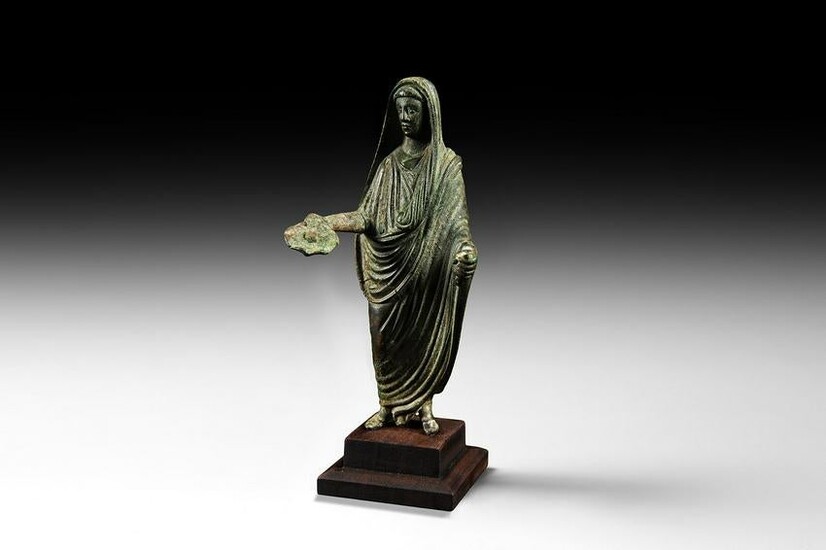Roman Cloaked Statuette with Patera
1st-2nd century AD. A bronze lead-filled statuette of a Roman Genius, personal tutelary or priest, dressed in a tunic and a large toga, the slightly turned head capite velato with detailed facial features; his right hand extended forwards and holding a patera, the left arm covered by the cloak and holding a part of a handle for an incense container or other cult object, wearing small boots, calcei; accompanied by a wooden stand and housed in a leatherette case. See similar statuette in Sautel, J., Vaison dans l’Antiquite’, I-III Avignon, 1926-1927, II, no.2878, pl.XXIII,1; Rolland, H., Bronzes Antiques De Haute Provence, Paris, 1965, items 178 & 460; for the discussion on Roman costume see Houston, M.G., Ancient Greek, Roman and Byzantine Costume and Decoration, London, 1977. 452 grams total, 14cm including stand (5 1/2"). From the collection of a Kensington gentleman; ex Mansour Gallery, Davies Street, London, 2013; formerly in an old private Japanese collection; accompanied by an academic report by Dr. Raffaele D’Amato; this lot has been checked against the Interpol Database of stolen works of art and is accompanied by AIAD certificate number no.10759-177410. The statuette shows the fully developed toga of the Imperial period, comprising a single semicircular piece of cloth about eighteen and a half feet long by seven feet deep at its centre. This type is seen on the Emperor Titus (Houston, 1977, fig.99), and worn with the capite velato on the Ara Pacis, (Houston, 1977, fig.102"). The ancients believed that that the college of the Pontifices was instituted in Rome by Numa Pompilius, the second king, the legendary organiser of the Roman national cult according to Dionysius of Halicarnassus, II, 73: 'The last branch of the ordinances of Numa related to the sacred offices allotted to those who held the higher priesthoods and the greatest power among the Romans. These, from one of the duties they perform, namely, the repairing of the wooden bridge, are in their own language called pontifices; but they have jurisdiction over the most weighty matters'. Numa has been said to have been the first Pontifex Maximus, so this function was seen as befitting the gravitas of the emperor. [A video of this lot can be viewed on the Timeline Auctions website]
Condition Report: Fine condition.
View it on
Sale price
Estimate
Time, Location
Auction House
1st-2nd century AD. A bronze lead-filled statuette of a Roman Genius, personal tutelary or priest, dressed in a tunic and a large toga, the slightly turned head capite velato with detailed facial features; his right hand extended forwards and holding a patera, the left arm covered by the cloak and holding a part of a handle for an incense container or other cult object, wearing small boots, calcei; accompanied by a wooden stand and housed in a leatherette case. See similar statuette in Sautel, J., Vaison dans l’Antiquite’, I-III Avignon, 1926-1927, II, no.2878, pl.XXIII,1; Rolland, H., Bronzes Antiques De Haute Provence, Paris, 1965, items 178 & 460; for the discussion on Roman costume see Houston, M.G., Ancient Greek, Roman and Byzantine Costume and Decoration, London, 1977. 452 grams total, 14cm including stand (5 1/2"). From the collection of a Kensington gentleman; ex Mansour Gallery, Davies Street, London, 2013; formerly in an old private Japanese collection; accompanied by an academic report by Dr. Raffaele D’Amato; this lot has been checked against the Interpol Database of stolen works of art and is accompanied by AIAD certificate number no.10759-177410. The statuette shows the fully developed toga of the Imperial period, comprising a single semicircular piece of cloth about eighteen and a half feet long by seven feet deep at its centre. This type is seen on the Emperor Titus (Houston, 1977, fig.99), and worn with the capite velato on the Ara Pacis, (Houston, 1977, fig.102"). The ancients believed that that the college of the Pontifices was instituted in Rome by Numa Pompilius, the second king, the legendary organiser of the Roman national cult according to Dionysius of Halicarnassus, II, 73: 'The last branch of the ordinances of Numa related to the sacred offices allotted to those who held the higher priesthoods and the greatest power among the Romans. These, from one of the duties they perform, namely, the repairing of the wooden bridge, are in their own language called pontifices; but they have jurisdiction over the most weighty matters'. Numa has been said to have been the first Pontifex Maximus, so this function was seen as befitting the gravitas of the emperor. [A video of this lot can be viewed on the Timeline Auctions website]
Condition Report: Fine condition.



